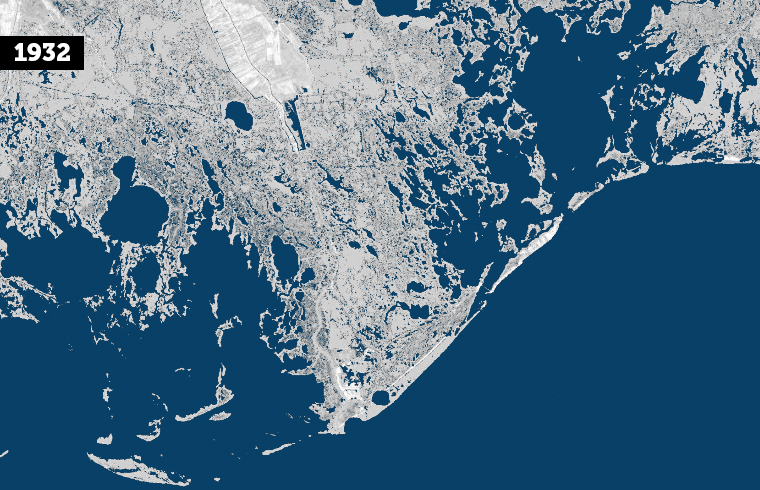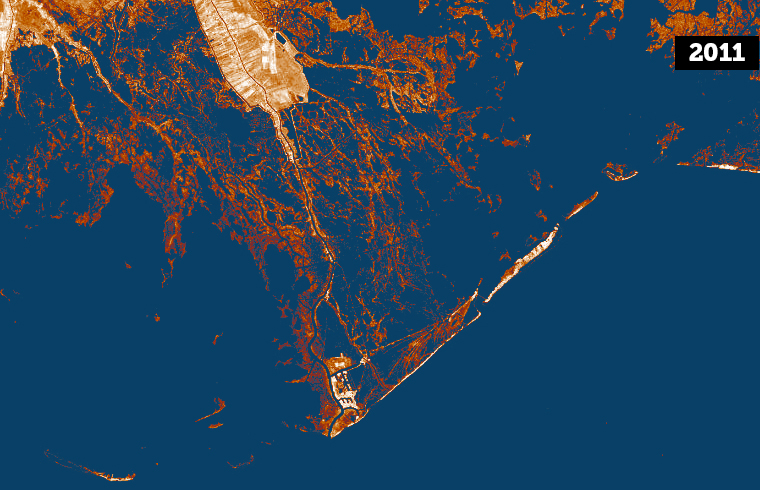Do we know how much remains below?
Because much of the oil sank to the seabed floor it’s hard to know exactly how much oil is still in the gulf, however scientists have estimated that an oily patch stretched for 1,250 square miles in the spill’s aftermath. Data was collected by the Natural Resources Damage Assessment that sampled 500 locations. And some of the oil still remains along fishing grounds that shrimpers use. Because shrimp can detect the contaminants in the water many of them moved around the spill. As a result, shrimpers in Texas to the west and as far east as Florida have seen shrimp they’ve never seen before. While that means better business for shrimpers in those states, shrimpers in Louisiana were hard hit and it’s unclear whether they will ever be able to catch sea food in the same abundance as they have for generations.
Featured scientist in our series, Claire Paris, PhD, University of Miami created models of where where we know the oil went in the aftermath. As shown in this animation (right), most of the oil fell down into a ravine beneath the stricken well, however some landed on elevations above affecting the shrimp habitat.
For further reading:
- Breaking Down the Myths and Misconceptions About the Gulf Oil Spill, Smithsonian.com
- Where did the BP Deep Water Horizon Oil Go, Ocean Conservancy
Model imagery by Claire Paris, PhD
Restoring the Gulf
The eroding chandeleur islands. Photo: Jake Price
Erosion in the Gulf of Mexico has been ongoing for a century, but has sped up dramatically in the past 20 years due to rising sea levels, increased and stronger hurricanes, industrial run off and the Deepwater Horizon oil spill that killed off shoreline vegetation that held soil in place. When BP was convicted of gross negligence they had to pay 18 billion in penalties, 8.8 billion of which is earmarked for coastal restoration.
Can the erosion be stopped?
In the past 80 years 2,000 square miles of the coast have turned into open water which means that New Orleans, once protected by land, is now ever closer to the Gulf of Mexico. Energy and shipping are also affected because the land that’s being lost also provided a valuable corridor for goods and services to be transported.
Unless the erosion can be stopped, the prospects for the future of the region do not look good, however if investments continue into restoring the coast there is hope. Restoring the coast is not only good for the environment: it also creates jobs which benefit the entire nation. In 2015 alone 32,000 water related jobs were created which is the largest industry driver in southern Louisiana.
Slide to view 8 decades of erosion along the Louisiana coast


Imagery comparing Gulf Coast land mass in 1932 and 2011. Photo: NOAA
For further reading:
- The Full LA Coastal Master Plan
- Losing Ground: Southeast Louisiana Is Disappearing, Quickly, Scientific American
- Where the Money for Restoration Goes: LA Gov breakdown PDF, State of Louisiana Coastal Protection and Restoration Authority
- How Louisiana's vanishing coast could create 13,600 jobs: NOLA
- Water Management Industry Eclipses Oil & Gas as Jobs Leader in SE Louisiana, 2nd Across Coastal Zone: RESTORE

In order to protect the gulf coast and New Orleans numerous projects have been implemented under the Coastal Master Plan funded in part from fines stemming from BP’s conviction of gross negligence. Source: Louisiana Costal Protection & Restoration Authority
Oysters:
An Endangered Gulf Resource
Photo: Jake Price
In a frantic rush to stem the flow of oil in the spill’s aftermath the Louisiana government flooded the estuarine system with fresh water. The human decision was disastrous—many regard the introduction of fresh water as being more harmful than the oil itself because the freshwater killed off much of the oyster habitat. Oysters require a certain amount of salinity to survive—when the fresh water was introduced the oysters could not survive and died off.
Why are oysters important?
By forming reefs, oysters provide a habitat where aquatic animals can protect themselves from predators. The reefs are part of what are called the multiple lines of defense. When a hurricane threatens the coast they blunt the impact of storm surges.
Although the oyster habitat was nearly killed off, it is, 7 years on, showing signs of recovery. On the western side of the Mississippi River oysters have almost made a full recovery owing mainly to oyster restoration projects.
Oysters play an essential role in keeping ecosystems healthy by filtering the water. By pumping large quantities of water through their gills they help remove plankton, bacteria, nitrates, phosphates, and other organic matter from the water that otherwise would pollute the environment. A single oyster is capable of filtering up to 50 gallons of water a day.
Source: Florida Oceanographic Society